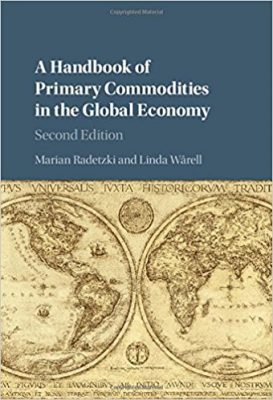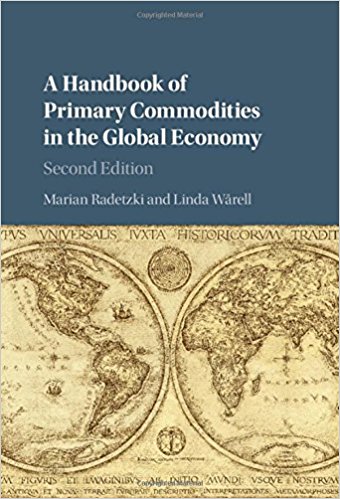 Authors: Marian Radetzki and Linda Warell
Authors: Marian Radetzki and Linda Warell
Publisher: Cambridge University Press – 305 pages
Book Review by: Sonu Chandiram
Primary commodities are goods derived from the primary economic sectors of a country such as but not limited to these activities: agriculture, hunting, fishing, forestry, mining, utilities. More specifically, these are unprocessed raw materials of agricultural and mineral origin, along with electricity, fuels, potable water, and others, in a national economy.
The authors point out in the Introduction that commodity prices were in the doldrums in the 1970s and 1980s, when “supply conditions for most commodities were quite relaxed most of the time, and prices remained suppressed.”
“This situation changed dramatically a few years into the present century when the most powerful and unusually enduring commodity boom began. This is when prices of most commodities in all categories, agricultural and food products, fuels, and minerals, “exploded,” the authors write. And from 2005 onwards, primary commodities “became truly hot stuff,” the authors point out.
But then, prices of primary commodities fell significantly in the years after 2010, ending the most powerful and enduring boom for this sector of the world market since World War II. What were some of the reasons for this commodity bust after 2010? The authors point out these among the significant factors that brought prices down:
- Large new supply facilities went into production around the world.
- Demand from China, one of the world’s largest commodity consumers, dropped.
- The shift in primary commodity consumption from the Western world to Asia, where growth rates of gross domestic product are much higher, along with population increases.
- A new, relaxed attitude toward commodity depletion
- Action by commodity cartels
- Revival of nationalism and state ownership
- Increasing influence of commodity exchanges on prices
- Investors were focused on technology companies that provided higher returns
This book is rich with data, presented in numerous figures and tables throughout its more than 300 pages. It is important that readers look closely at these illustrations to gain a better overall understanding of commodities in general.
To give you a broad overview of the contents of this significant research work by the authors and the insight they provide based on their knowledge and experience, we present below the book’s outline and he titles of its chapters:
List of Figures
List of Tables
Acknowledgements
Introduction
- The Historical Framework
- The Geography of Commodity Production and Trade
- Comparative Advantage and Trade Policy Distortions
- Fossil Fuels
- Price Formation and Price Trends in Commodities
- Commodity Booms
- The Commodity Exchanges, Commodity Investments, and Speculation
- Threats of Resource Depletion and Sustainability of the Extraction Industries
- Fears Regarding and Measures to Assure Supply Security
- Producer Cartels in International Commodity Markets
- Public Ownership of Commodity Production
- The Monoeconomics: Issues Related by Heavy Dependence on Commodity Production and Exports
References
Index
This book is useful for these categories of people:
- Executives at companies that produce, market, distribute, and export commodities
- Government officials in countries that import or export commodities
- Members of the financial community such as managers at investment banks, hedge funds, mutual funds, pension funds, and the like
- Policy makers at government agencies
- Purchasing managers at government agencies and firms that need commodities
- Students of business, economics, finance, and related subjects
- Traders who buy and sell commodities
This is an excellent book reflecting the deep knowledge of the authors about commodities, and the causes of price movements. Their insight into the subject is based on decades of research and understanding of the main causative factors.
Authors:
Marian Radetzki is Professor of Technology at Lulea University of Technology in Sweden. He has authored more than two dozen books, the most recent being The Price of Oil, with Cambridge University Press, and has undertaken consulting assignments for industry, governments, and international organizations such the World Bank and UNDP.
Linda Warell is Associate Professor of Economics at Lulea University of Technology in Sweden. She is the Editor-in-Chief of Mineral Economics, a multidisciplinary journal focusing on economic and policy issues in the mineral industries, and has published numerous studies on competition and public policy questions, predominantly in the mineral industry.







